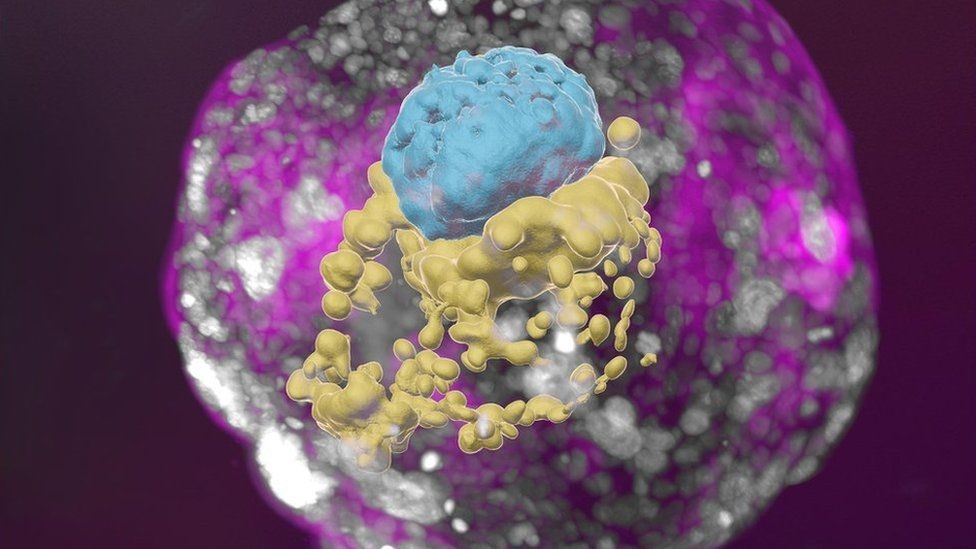Description

Disclaimer: Copyright infringement not intended.
Context
- Scientists have successfully created a model of a human embryo in a lab setting without utilizing sperm or egg cells.
- This achievement was made possible through the use of stem cells, which are undifferentiated cells capable of transforming into various cell types in the body.
- The process involved introducing specific chemicals that directed the stem cells to differentiate and form an embryo-like structure, mimicking the early stages of embryonic development.
Details
Creating the Embryo Model
- Stem cells played a pivotal role in this breakthrough. These cells possess the remarkable ability to transform into different cell types, and in this case, they were programmed to simulate the characteristics of early-stage embryonic cells.
- Chemical cues were introduced into the laboratory environment to provide the necessary signals and instructions for the stem cells to differentiate into the diverse cell types required for embryonic development.
- This process led to the spontaneous assembly of a portion of these cells into an embryo-like structure, which underwent differentiation to represent various components of an embryo, including fetal cells, cells providing nutrients to the fetus, cells directing body development, and cells forming supporting structures like the placenta and umbilical cord.
Efficiency
- While the achievement is groundbreaking, it's important to note that only approximately 1% of the cell mixture successfully assembled into an embryo-like structure, indicating that the process remains relatively inefficient and presents room for improvement.
Ethical Importance
- Studying the early stages of embryo development has always been ethically challenging because it becomes difficult to observe embryos once they have implanted in the uterus.
- These laboratory-grown embryo-like models provide an ethically responsible means of studying the initial stages of embryonic development, eliminating the need for donated embryos or in-vivo studies.

Significance of Embryo Research
- Research into early embryonic development holds immense importance as the majority of miscarriages and birth defects occur during these crucial early stages.
- By understanding the genetic and epigenetic factors that influence embryonic development, scientists aim to uncover the causes of these issues and potentially develop more effective treatments.
The 14-Day Limit
- In many countries, including the UK, there is a legal and ethical limit on conducting research on embryos, which restricts growing them in a laboratory beyond a 14-day period.
- This limit aligns with the approximate time when embryos naturally complete implantation in the uterus and marks the point at which individualization begins.
Insights from Models
- Embryo-like models, such as the one created by the Israeli team, have yielded valuable insights into early development.
- Researchers have gained a better understanding of errors occurring during DNA duplication and the roles of specific genes in fetal development.
- These models enable controlled experiments on gene functions that are difficult to conduct with natural embryos.
Future Possibilities
- While these laboratory-created embryo models are not intended for reproductive purposes, they offer a unique opportunity for scientists to manipulate genes and explore their developmental roles in a controlled setting.
- This research could advance our understanding of embryonic development and potentially contribute to medical advancements, particularly in the field of genetic medicine.
About Human Embryo
Definition of a Human Embryo
- A human embryo is the earliest developmental stage of a human organism following fertilization (the union of a sperm cell and an egg cell). It represents the initial phase of human life.
Embryonic Development Timeline
- Human embryonic development is divided into several stages:
- Fertilization: Occurs when a sperm cell penetrates and fertilizes an egg cell, forming a zygote.
- Cleavage: The zygote undergoes multiple rounds of cell division, producing a ball of cells called a morula.
- Blastocyst Formation: The morula continues to divide and eventually forms a blastocyst, consisting of an inner cell mass (which becomes the embryo) and an outer layer (which becomes the placenta).
- Implantation: The blastocyst attaches to the uterine wall and begins to grow.
- Gastrulation: The embryo undergoes a process called gastrulation, during which it forms three primary germ layers: ectoderm, mesoderm, and endoderm.
- Organogenesis: The germ layers differentiate into specific cell types, leading to the formation of organs and tissues.
Critical Periods in Embryonic Development
- Certain periods during embryonic development are particularly critical for the proper formation of organs and body structures. These stages are highly susceptible to genetic, environmental, or teratogenic (causing birth defects) influences.
- The first trimester is the most critical period, during which organogenesis occurs.
Importance of the Human Embryo
- The human embryo is of paramount importance in the context of human reproduction and development.
- It represents the beginning of an individual's life and has unique genetic characteristics determined by the combination of genetic material from both parents.
- Understanding embryonic development is crucial for addressing issues related to fertility, birth defects, and genetic diseases.
Ethical and Legal Considerations
- Due to its significance, research involving human embryos is subject to stringent ethical and legal guidelines.
- Many countries have established limits on embryo research, including a 14-day rule, beyond which embryos cannot be cultured in the laboratory.
Medical and Scientific Research
- The study of human embryos plays a vital role in advancing medical knowledge and treatments.
- It provides insights into early human development, helping researchers understand genetic, epigenetic, and environmental factors that influence development.
Assisted Reproductive Technologies (ART)
- In vitro fertilization (IVF) is a common ART technique that involves the manipulation and observation of human embryos in a laboratory setting before implantation in the uterus.
- Preimplantation genetic diagnosis (PGD) allows for the screening of embryos for genetic abnormalities before implantation, reducing the risk of certain inherited diseases.
|
PRACTICE QUESTION
Q. Discuss the significance of studying human embryos in scientific research and medical advancements. Explain the ethical considerations and regulatory frameworks surrounding human embryo research. (150 Words)
|
.jpg)
https://indianexpress.com/article/explained/without-sperm-or-egg-how-scientists-grew-whole-model-of-human-embryo-8929693/














